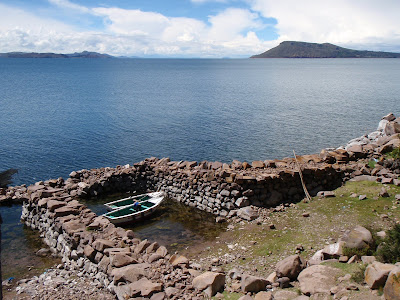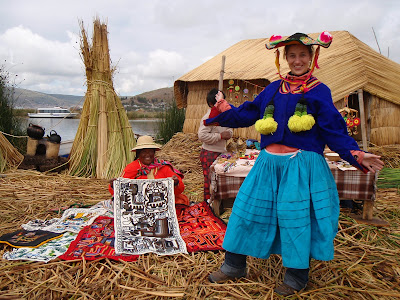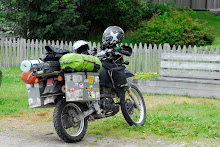


Carb change for high altitude
As we motored along we were appreciating the beauty of Bolivia. I shutter at the fact that we almost passed it in favor of hitting the Pan America to Chilie. We were treated to clear skies and glacier capped mountains that would rival any along the Columbia Ice Field Parkway in Alberta.
The air temperature is very cold and Julie and I have donned our winter riding gear that we packed away back in Texas. The gods must have been watching out for us because for about 2 hours of the 7 hours that we rode today the rain was falling on either side of us but not directly on us. The asphalt was wet but the clouds had split over the road keeping us dry from the feet up.
Most of the ride from La Paz to Potosi was at elevations greater than 4300 meters. I was thanking my lucky stars that I chose to work on the carb the day before at only 3800 meters in the sun in anticipation of greater altitudes. Had we not taken the time we would have been putting along that stretch at 60 -70 km an hour on the flats, and 30 -40km on the hills. Alas I was brimming ear to ear in the feeling of accomplishment at such a feat of mechanical brilliance.
The ride today was much similar to the ride across the Peruvian Highlands, however, the Bolivian highlands had a paved road and was seemingly situated in a high valley as we were motoring between rolling rounded mountain peaks the entire way. Yesterday we saw National team speed walkers training, who were taking advantage of the high altitude and good roads.
Ive been taking care to fill up every 100km so as to avoid running out of gas. Already twice we have driven 300km between fill ups as the towns have been completely dry with huge 40 and 60 car & truck line ups waiting on the side of the highway for the next fuel delivery truck to arrive. The new Carb jetting has our fuel economy back under control and we are getting our standard 55 miles to the gallon again.
We pulled into Potosi...a beautiful colonial town on the side of a mountain. The city was established in the 1550s and has neat narrow streets of wide flat cobbles. As mentioned before it was once the richest city in all of South America for its silver mining operation. Mining is still occuring today and you can actually take a mine tour. I bet it would be pretty interesting, knowing that the technology and safety of the place probably wouldnt be up to snuff.
As we were heading out for dinner we were halted by a procession of priests and other church members proceeding in a huge parade toward the huge beautiful stone church. There were alot of old white men and a few locals as well. In the middle of the procession was a bunch of locals wearing colorful beads and traditional dress playing recorders and drums while hopping and dancing along side the serious and long faced white guys with folded hands over their gut. I looked up toward the bell tower and to my suprise there were young men up there (with out fall protection). They were man handling the ringers inside the huge bells with their bare hands swinging the dinger to and fro. The whole parade was increadible in that it caused a mini traffic jam and Im sure that if this sort of thing happened in Canada someone would be writng a letter to the city. Alas after 15 minutes all was clear and everyone flooded into the church.
Tomorrow we plan to head to the Bolivian Salt flats (Salar de Uyuni) It was an ancient inland lake that due to techninic upheaval has drained and thus precipitated all of its salts forming a salt desert more that 12,000 km square. It should be pretty interesting.
The air temperature is very cold and Julie and I have donned our winter riding gear that we packed away back in Texas. The gods must have been watching out for us because for about 2 hours of the 7 hours that we rode today the rain was falling on either side of us but not directly on us. The asphalt was wet but the clouds had split over the road keeping us dry from the feet up.
Most of the ride from La Paz to Potosi was at elevations greater than 4300 meters. I was thanking my lucky stars that I chose to work on the carb the day before at only 3800 meters in the sun in anticipation of greater altitudes. Had we not taken the time we would have been putting along that stretch at 60 -70 km an hour on the flats, and 30 -40km on the hills. Alas I was brimming ear to ear in the feeling of accomplishment at such a feat of mechanical brilliance.
The ride today was much similar to the ride across the Peruvian Highlands, however, the Bolivian highlands had a paved road and was seemingly situated in a high valley as we were motoring between rolling rounded mountain peaks the entire way. Yesterday we saw National team speed walkers training, who were taking advantage of the high altitude and good roads.
Ive been taking care to fill up every 100km so as to avoid running out of gas. Already twice we have driven 300km between fill ups as the towns have been completely dry with huge 40 and 60 car & truck line ups waiting on the side of the highway for the next fuel delivery truck to arrive. The new Carb jetting has our fuel economy back under control and we are getting our standard 55 miles to the gallon again.
We pulled into Potosi...a beautiful colonial town on the side of a mountain. The city was established in the 1550s and has neat narrow streets of wide flat cobbles. As mentioned before it was once the richest city in all of South America for its silver mining operation. Mining is still occuring today and you can actually take a mine tour. I bet it would be pretty interesting, knowing that the technology and safety of the place probably wouldnt be up to snuff.
As we were heading out for dinner we were halted by a procession of priests and other church members proceeding in a huge parade toward the huge beautiful stone church. There were alot of old white men and a few locals as well. In the middle of the procession was a bunch of locals wearing colorful beads and traditional dress playing recorders and drums while hopping and dancing along side the serious and long faced white guys with folded hands over their gut. I looked up toward the bell tower and to my suprise there were young men up there (with out fall protection). They were man handling the ringers inside the huge bells with their bare hands swinging the dinger to and fro. The whole parade was increadible in that it caused a mini traffic jam and Im sure that if this sort of thing happened in Canada someone would be writng a letter to the city. Alas after 15 minutes all was clear and everyone flooded into the church.
Tomorrow we plan to head to the Bolivian Salt flats (Salar de Uyuni) It was an ancient inland lake that due to techninic upheaval has drained and thus precipitated all of its salts forming a salt desert more that 12,000 km square. It should be pretty interesting.
















































